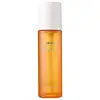What's inside
What's inside
 Key Ingredients
Key Ingredients

 Benefits
Benefits

 Concerns
Concerns

 Ingredients Side-by-side
Ingredients Side-by-side

Water
Skin ConditioningDipropylene Glycol
HumectantBetaine
HumectantPropanediol
SolventAlcohol Denat.
AntimicrobialGlycosyl Trehalose
Emulsion StabilisingGlycerin
Humectant1,2-Hexanediol
Skin ConditioningPanthenol
Skin ConditioningPentylene Glycol
Skin ConditioningErythritol
HumectantHydrogenated Starch Hydrolysate
HumectantTriethylhexanoin
MaskingDiphenyl Dimethicone
EmollientPolyglyceryl-10 Myristate
Skin ConditioningCeramide NP
Skin ConditioningSucrose Distearate
EmollientEthylhexylglycerin
Skin ConditioningSodium Hyaluronate
HumectantTheobroma Cacao Seed Extract
AntioxidantPelargonium Graveolens Flower Oil
MaskingOlea Europaea Fruit Oil
MaskingCitrus Aurantium Bergamia Fruit Oil
MaskingC12-14 Pareth-12
EmulsifyingHydrogenated Lecithin
EmulsifyingAcrylates/C10-30 Alkyl Acrylate Crosspolymer
Emulsion StabilisingTromethamine
BufferingCarbomer
Emulsion StabilisingGlyceryl Polymethacrylate
Glyceryl Stearate
EmollientDextrin
AbsorbentSalvia Officinalis Oil
MaskingCitronellol
PerfumingDisodium EDTA
CI 19140
Cosmetic ColorantWater, Dipropylene Glycol, Betaine, Propanediol, Alcohol Denat., Glycosyl Trehalose, Glycerin, 1,2-Hexanediol, Panthenol, Pentylene Glycol, Erythritol, Hydrogenated Starch Hydrolysate, Triethylhexanoin, Diphenyl Dimethicone, Polyglyceryl-10 Myristate, Ceramide NP, Sucrose Distearate, Ethylhexylglycerin, Sodium Hyaluronate, Theobroma Cacao Seed Extract, Pelargonium Graveolens Flower Oil, Olea Europaea Fruit Oil, Citrus Aurantium Bergamia Fruit Oil, C12-14 Pareth-12, Hydrogenated Lecithin, Acrylates/C10-30 Alkyl Acrylate Crosspolymer, Tromethamine, Carbomer, Glyceryl Polymethacrylate, Glyceryl Stearate, Dextrin, Salvia Officinalis Oil, Citronellol, Disodium EDTA, CI 19140
Water
Skin ConditioningAlcohol Denat.
AntimicrobialMalpighia Emarginata Fruit Extract
Skin ConditioningPropylene Glycol
HumectantEuterpe Oleracea Fruit Extract
3-O-Ethyl Ascorbic Acid
Skin ConditioningCeramide AP
Skin Conditioning1,2-Hexanediol
Skin ConditioningPEG-60 Hydrogenated Castor Oil
EmulsifyingBis-PEG-18 Methyl Ether Dimethyl Silane
EmollientCaffeine
Skin ConditioningEthylhexylglycerin
Skin ConditioningDisodium EDTA
Parfum
MaskingSodium Magnesium Silicate
Limonene
PerfumingGlutathione
Tocopherol
AntioxidantWater, Alcohol Denat., Malpighia Emarginata Fruit Extract, Propylene Glycol, Euterpe Oleracea Fruit Extract, 3-O-Ethyl Ascorbic Acid, Ceramide AP, 1,2-Hexanediol, PEG-60 Hydrogenated Castor Oil, Bis-PEG-18 Methyl Ether Dimethyl Silane, Caffeine, Ethylhexylglycerin, Disodium EDTA, Parfum, Sodium Magnesium Silicate, Limonene, Glutathione, Tocopherol
 Reviews
Reviews

Alternatives
Ingredients Explained
These ingredients are found in both products.
Ingredients higher up in an ingredient list are typically present in a larger amount.
1,2-Hexanediol is a synthetic liquid and another multi-functional powerhouse.
It is a:
- Humectant, drawing moisture into the skin
- Emollient, helping to soften skin
- Solvent, dispersing and stabilizing formulas
- Preservative booster, enhancing the antimicrobial activity of other preservatives
Alcohol Denat. is an alcohol with a denaturant property. It is created by mixing ethanol with other additives.
This ingredient gets a bad rep because it is irritating and drying - mostly due to its astringent property. Astringents draw out natural oils in tissue, constricting pores and leaving your skin dried out.
However, alcohol denat. is not all that bad.
Due to its low molecular weight, alcohol denat. tends to evaporate quickly. One study on pig skin found half of applied alcohol evaporated in 10 seconds and less than 3% stayed on skin.
This also helps other ingredients become better absorbed upon application.
Studies are conflicted about whether this ingredient causes skin dehydration. One study from 2005 found adding emollients to propanol-based sanitizer decreased skin dryness and irritation. Another study found irritation only occurs if your skin is already damaged.
Small amounts of alcohol are generally tolerated by oily skin or people who live in humid environments.
The rule of thumb is if this alcohol is near the end of an ingredients list, it will probably not affect your skin much.
Also...
This ingredient has antimicrobial and solvent properties.
The antimicrobial property helps preserve products and increase their shelf life. As a solvent, it helps dissolve other ingredients.
Other types of astringent alcohols include:
Learn more about Alcohol Denat.Disodium EDTA plays a role in making products more stable by aiding other preservatives.
It is a chelating agent, meaning it neutralizes metal ions that may be found in a product.
Disodium EDTA is a salt of edetic acid and is found to be safe in cosmetic ingredients.
Learn more about Disodium EDTAEthylhexylglycerin (we can't pronounce this either) is commonly used as a preservative and skin softener. It is derived from glyceryl.
You might see Ethylhexylglycerin often paired with other preservatives such as phenoxyethanol. Ethylhexylglycerin has been found to increase the effectiveness of these other preservatives.
Water. It's the most common cosmetic ingredient of all. You'll usually see it at the top of ingredient lists, meaning that it makes up the largest part of the product.
So why is it so popular? Water most often acts as a solvent - this means that it helps dissolve other ingredients into the formulation.
You'll also recognize water as that liquid we all need to stay alive. If you see this, drink a glass of water. Stay hydrated!
Learn more about Water